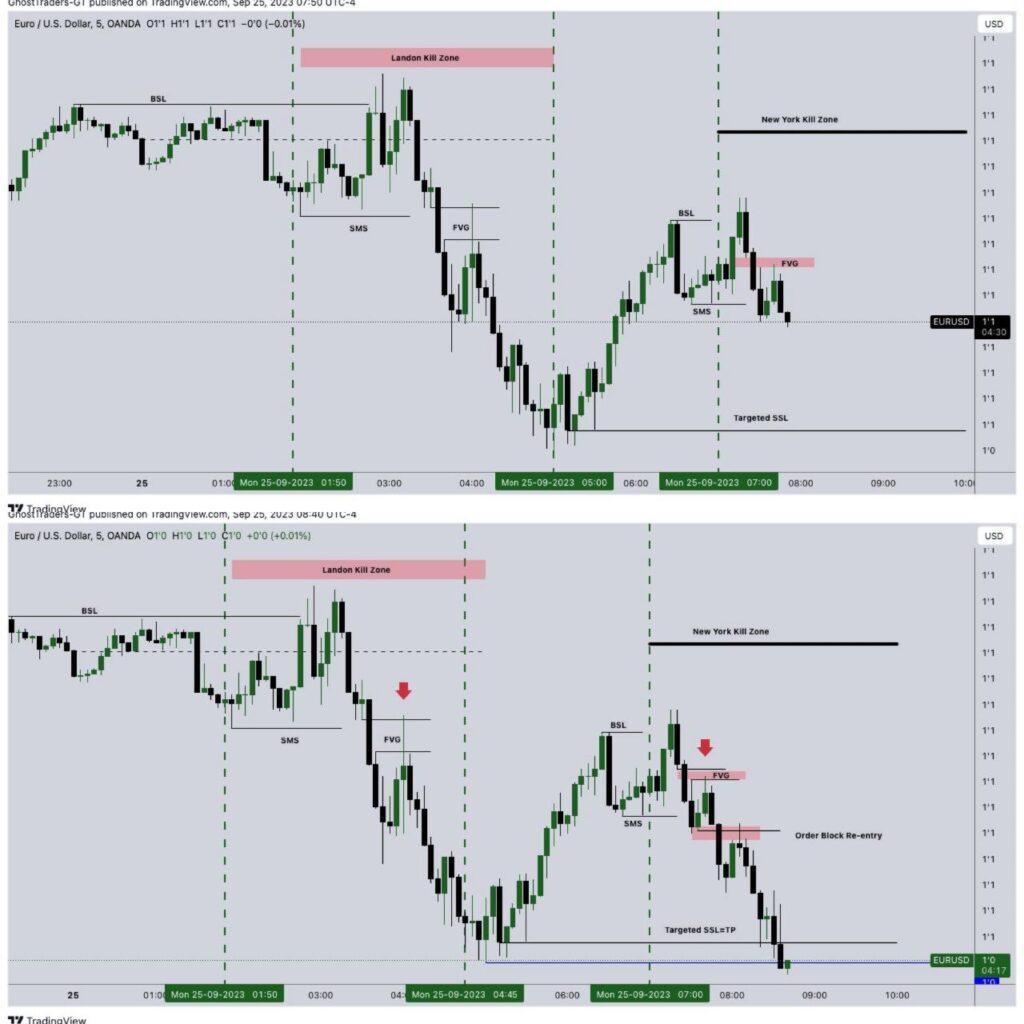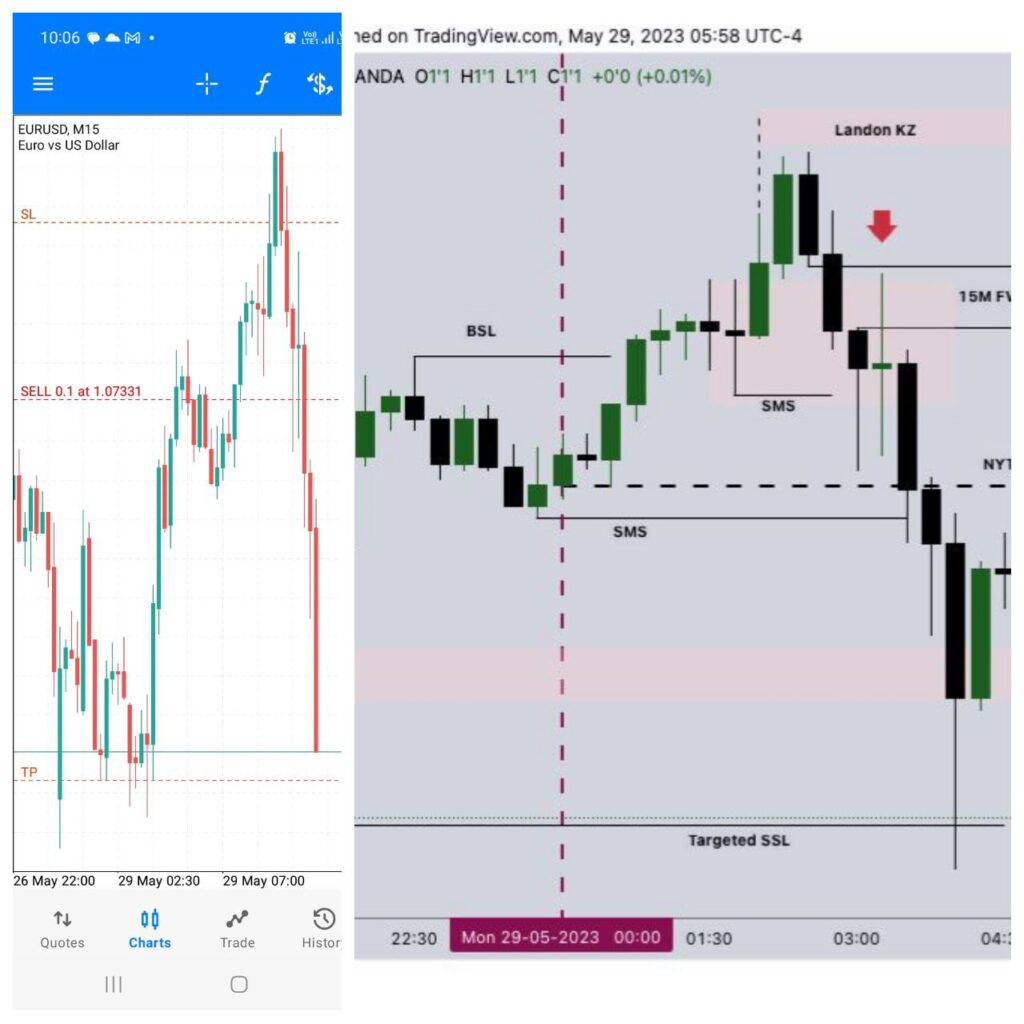Day trading involves fast-paced, short-term trades, intending to capitalize on price movements within a single day. Day traders buy and sell assets like stocks, forex, or cryptocurrency, aiming to close all positions by the market’s close, seeking quick profits from rapid fluctuations.
Swing trading, on the other hand, focuses on longer-term price movements, with trades lasting several days or weeks. It is more suitable for part-time traders or those with full-time jobs, as it requires less constant attention than day trading. For beginners, I recommend starting with swing trading and transitioning to day trading as experience grows.
I use a mix of both swing and day trading, depending on my schedule. However, I recommend that beginners start with swing trading, as day trading tends to be more challenging. Higher timeframes, such as daily or weekly charts, are less noisy and cluttered with multiple candles, making it easier to identify trends and patterns.
For example, one candle on a daily timeframe in forex represents 24 candles on a one-hour chart. This difference can overwhelm traders, making it difficult to perform technical analysis on smaller timeframes. Many traders find it harder to make sense of price movements on shorter timeframes due to the increased volume of data.
The key to mastering day trading lies in understanding that the market is fractal, meaning price movements on smaller timeframes reflect patterns seen on higher timeframes. By analyzing higher timeframes and then refining your entries on smaller timeframes, you can develop a more precise trading strategy. For instance, a daily order block might act as a mitigation block or breaker on an hourly chart. This is why I always start my analysis with higher timeframes and work down to smaller ones, switching between multiple timeframes to fine-tune my trades.
Who’s Cut Out for Day Trading?
Day trading isn’t for everyone. It’s a demanding and fast-paced activity that requires both time and dedication to closely monitor the markets throughout trading hours. It’s best suited for full-time traders or those with flexible schedules who can stay focused on the screen for extended periods. While the idea of casually day trading from a beach chair sounds appealing, the reality is much more intense, involving sharp focus and quick decision-making.
The good news? This guide will introduce you to a beginner-friendly intraday strategy, designed to help you get started with day trading—even if you’re new to the fast-paced world of intraday trading.
How To Start Day Trading
Let’s be honest: jumping into day trading without a strategy is like bringing a pool noodle to a sword fight. You might get lucky, but more likely, you’ll end up blowing up your trading account.
Our day trading course is your secret weapon, setting you apart from the crowd chasing the latest meme stocks, hoping for a viral moonshot (spoiler: reliable strategies beat internet hype every time).
A strong day trading strategy should give traders enough opportunities to generate a decent income. Ideally, it should help you earn at least 5-10% returns on your trading account. But if you’re starting with a small account, a 5-10% profit might not be enough to cover the bills. In that case, focus on building your capital first—there’s no shame in starting small.
If making a living off a 5-10% return feels like climbing Mount Everest in flip-flops, don’t worry—there are other options! For example, you can look into prop firms, which lend you money to trade with in exchange for a share of the profits. We’ve got an entire guide dedicated to navigating the prop firm landscape, so you’ll know what to expect.
Remember: a solid strategy is your first step toward success in day trading. It won’t make you a market-dominating powerhouse overnight, but it will give you the tools to trade more effectively and confidently.
Course Bundle
Up To 50% Off
Access all courses with a once-off purchase.
Benefits

day trading for beginners
Knowledge is power, they say. Especially when you’re staring down charts and trying to predict the next market move without your fortune cookie (although, hey, if a prophetic cookie exists, hit me up).
The point is, before you jump into day trading like a lightsaber duel with a blindfolded Tauntaun (bad idea), you gotta learn the ropes.
There’s a wealth of knowledge out there—free online courses, YouTube channels (just be wary of the ones promising “guaranteed profits in 24 hours”), and even a quick Google search can teach you a lot. But sorting through all that content can feel like wading through a swamp of clickbait and ads.
Cut Through the Noise (and Maybe the Ads)To save time and avoid wasting energy on ineffective strategies, start with our free trading courses. These will help you build a solid foundation. Once you’re no longer confusing a candlestick chart with a barcode, check out our paid courses, where we dive deep into proven, time-tested strategies.
My Course Catastrophe (and Triumph!)
I’ve been there—some paid courses were worth their weight in gold, while others made me wish for the simplicity of staring at a rock (seriously, some explanations were rock-solid…ly bad). But the valuable ones, combined with persistence, are why I can share my trading knowledge with you today.
I’ve gone through courses on support and resistance, candlestick patterns, MACD indicators, and fundamental analysis. I even took a course from a trader called Forex Broker Killer, who used a strategy involving two accounts—one for buying, and one for selling during news events. But the market is smarter than that, and I quickly learned it wasn’t sustainable. I didn’t make money from that method, but it was a learning experience nonetheless.
The takeaway? Not all strategies work, but good courses can make a big difference. Keep learning, stay persistent, and focus on strategies that stand the test of time.
3. Building Your Trading Empire (One Profit at a Time)
Day trading is a long game. Don’t get too hung up on daily results (unless they’re all wins—then feel free to celebrate!). Instead, focus on your overall progress, tracking it monthly or even quarterly. By risking just 1-2% per trade and aiming for a 5-10% return per month, you’ll set yourself up for long-term success.
If you can stick to this approach and make it through five years, you’ve officially earned the title of “real trader.” Most beginners don’t make it that far—they often drop out within those first five years, overwhelmed by unrealistic expectations.
4. Forex Day Trading Reality Check: No Lambos (Yet)
Forget the “get rich quick” schemes. Forex, like any market, demands dedication and realistic expectations. Mastering profitable day trading can take beginners years. Don’t get discouraged by comparing yourself to others with fancy cars and private islands (they probably put in the hard work too). Focus on your learning journey and celebrate your wins, big or small.
Many beginners get excited about day trading, seeing it as a quick way to make money by simply jumping in and out of trades. While it’s possible, inexperienced traders often struggle due to a lack of understanding of both technical and fundamental analysis. Since day trading relies on smaller timeframes, which are noisier and more volatile, it’s easy to become confused and frustrated, leading to disappointment.
The solution? Start by focusing on higher timeframe analysis. Once you understand the bigger picture of price movements, you can shift to smaller timeframes. This works because the market is fractal—what you see on a higher timeframe will play out in smaller timeframes multiple times. If this sounds confusing, consider taking our trading course for a more in-depth explanation.
Most Profitable Day Trading Strategy
This is one of the most profitable trading strategies, this video is taken from our premium trading course.
Follow the trading Ideas as per the trading setup!
– Wait for the narrative/story to unfold meeting the requirements.
– Do not trade if requirements are not met!
– Trade management will help manage risk!
Benefits of day trading
- There is no overnight risk: Intraday trading, by definition, doesn’t require an open position overnight.
- Limited intra-day risk: The trades of day traders are usually short-term, lasting about one to four hours depending on market volatility, so the risk of long-term trades is minimized.
- Time-flexible trading: Day trading might suit people who desire flexibility in their trading. Adding an element of time to price action gives traders more flexibility
- An intraday trading model with specific requirements to look at a specific time is ideal for minimizing risk and maximizing flexibility.
- Multiple trade opportunities. Trading opportunities unfold frequently with this intraday trading strategy. In a week a trade can have at least 2-5 trading setups with an average of 30 pips per trade. This gives traders the advantage of risking less and not having to wait for weeks like swing trading.
Benefits of Swing Trading:
- Less Time-Intensive: You don’t need to monitor the markets constantly, making it more flexible for people with other commitments.
- Potential for Larger Profits: Swing traders can benefit from larger price movements over days or weeks.
- Lower Stress Levels: Holding trades for a longer period generally involves less stress compared to the fast pace of day trading.
Challenges of Swing Trading:
- Overnight Risks: Positions are subject to overnight gaps, which can result in unexpected losses.
- Swap Fees: Traders may incur overnight financing fees, adding to the overall cost.
- Requires Patience: Swing trading necessitates a calm temperament to handle market fluctuations.
- Margin Requirements: Longer-term trades may require more margin, depending on the broker.
Key Differences Between Day Trading and Swing Trading
| Aspect | Day Trading | Swing Trading |
|---|---|---|
| Time Commitment | Requires full-time focus; trades are closed within a day. | Can be part-time; trades are held for days or weeks. |
| Trade Frequency | Multiple trades per day. | Fewer trades, but held longer. |
| Risk Exposure | No overnight risk. | Exposed to overnight market movements. |
| Strategy & Analysis | Relies heavily on technical indicators and news events. | Combines technical and fundamental analysis. |
Day Trading vs. Swing Trading: Which Style is Right for You?
Personality Fit:
- Day Trading: If you enjoy fast decision-making and have time to closely monitor the market, day trading may be suitable for you.
- Swing Trading: If you prefer a more relaxed, methodical approach and can handle holding positions overnight, swing trading might be a better fit.
Risk Tolerance:
- Day Trading: Higher risk due to increased market volatility.
- Swing Trading: Moderate risk, as positions are held longer, offering steadier gains.
Lifestyle Considerations:
- Day Trading: Demands constant attention and energy, making it more suitable for full-time traders or those with flexible schedules.
- Swing Trading: Offers more flexibility and is ideal for part-time traders.
Common Misconceptions About Day and Swing Trading
- Day Trading Guarantees Quick Wealth: Contrary to popular belief, day trading is not a quick path to riches. It requires skill, discipline, and experience. Beginner traders often face significant losses before becoming consistently profitable.
- Swing Trading is Too Slow for Significant Profits: While swing trading has fewer trades, it targets larger price moves, making it possible to generate substantial profits over time.
Related Post:
Best Order Block Trading Guide
Fair Value Gaps and Liquidity Void Guide



